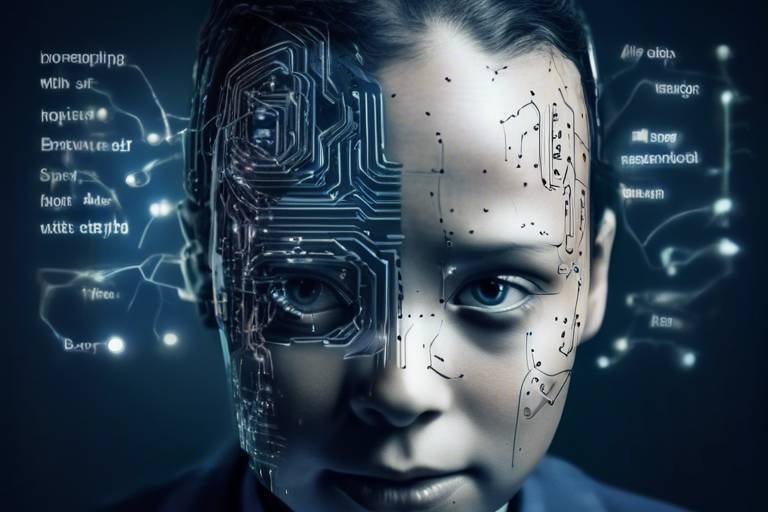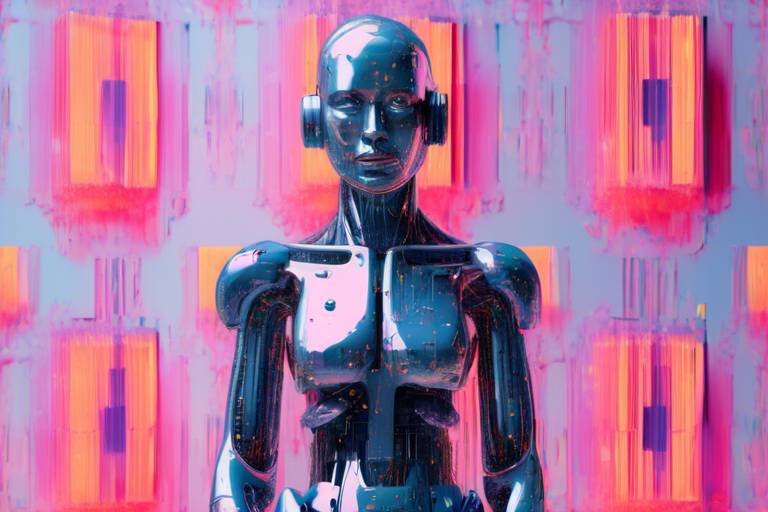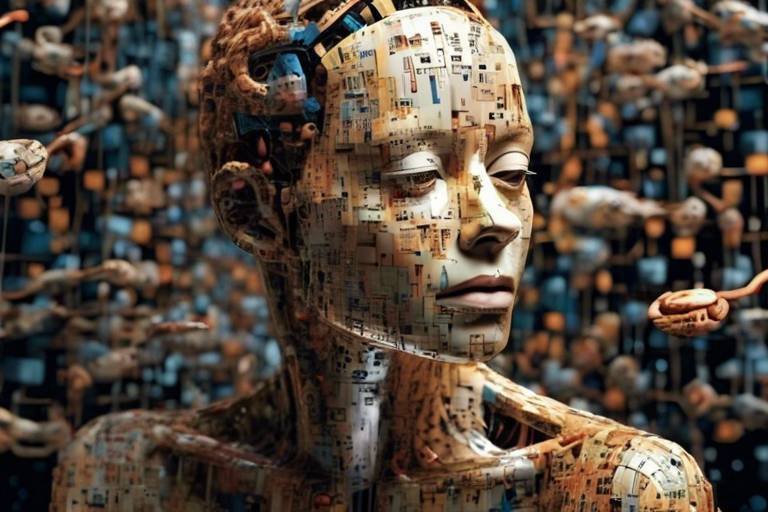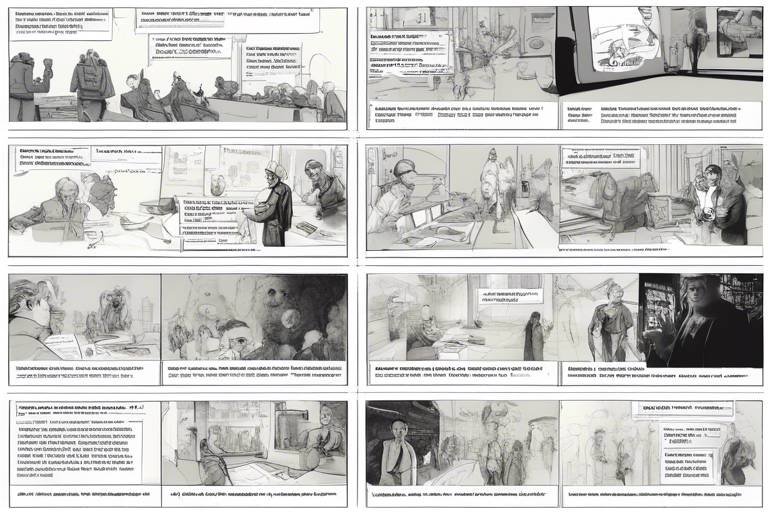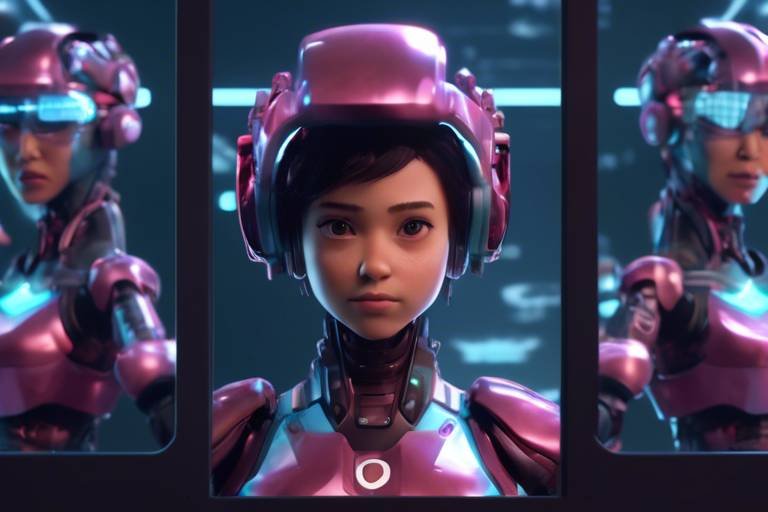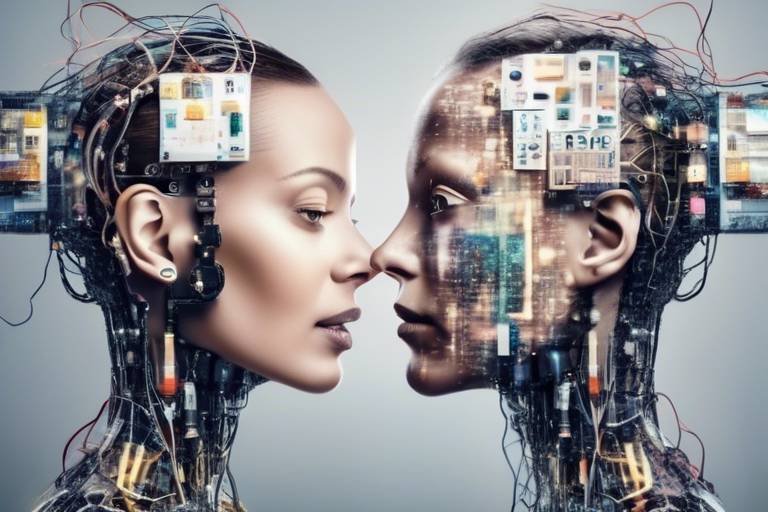The Role of AI in Storytelling
In the ever-evolving landscape of storytelling, artificial intelligence (AI) is emerging as a transformative force, reshaping how narratives are crafted and consumed. Imagine a world where your favorite story adapts to your preferences, where characters evolve based on your choices, and where every plot twist is tailored just for you. This isn’t the stuff of science fiction; it’s the reality we are stepping into. As AI technologies advance, they are not just tools but rather creative partners that collaborate with writers, enhancing their ability to tell stories that resonate deeply with audiences.
From novels to films and even video games, AI is making its mark across various mediums. It’s like having a brainstorming buddy who never runs out of ideas! Writers can now leverage AI to generate plot outlines, develop intricate character arcs, and even suggest dialogue that feels authentic. This partnership allows creators to push the boundaries of their imagination, leading to richer and more engaging storytelling experiences. The synergy between human creativity and AI's analytical prowess is opening doors to narratives that were previously unimaginable.
But the impact of AI on storytelling goes beyond just enhancing creativity. With the power of personalized storytelling, AI algorithms analyze user data to craft narratives that resonate on a personal level. Picture this: you’re reading a story that adapts based on your reactions, preferences, and even your mood. This kind of interactivity fosters a deeper emotional connection and engagement, making the audience feel like an integral part of the narrative. It’s as if the story is alive, breathing and evolving with you, creating a unique experience every time.
As we delve deeper into the implications of AI in storytelling, we find ourselves at the intersection of technology and ethics. While AI can enhance creativity and engagement, it also raises questions about originality, bias, and the potential for manipulation in narratives. The future of storytelling is not just about what stories are told but also about who gets to tell them and how these stories are shaped. As we explore this fascinating realm, it’s crucial to consider both the opportunities and challenges that AI presents to writers and audiences alike.
- How does AI assist in the writing process? AI tools can help generate ideas, suggest plot developments, and even create character profiles, acting as a collaborative partner for writers.
- What is personalized storytelling? Personalized storytelling uses AI to analyze user preferences and tailor narratives to enhance emotional engagement.
- Are there ethical concerns regarding AI in storytelling? Yes, issues like ownership of AI-generated content, potential biases in narratives, and the risk of manipulation are significant ethical considerations.
- What does the future hold for AI in storytelling? The future promises innovative storytelling experiences, with AI enabling more interactive and immersive narratives that adapt to audience feedback.

AI as a Creative Partner
In the ever-evolving landscape of storytelling, artificial intelligence is emerging as a remarkable ally for writers. Imagine having a brainstorming buddy who never runs out of ideas and can help you develop your plots and characters with surprising depth. That’s precisely what AI offers! With its ability to analyze vast amounts of data and recognize patterns, AI tools are transforming the way stories are conceived and crafted. Writers can tap into these tools to spark creativity, generating unique concepts that they might not have considered on their own.
One of the most exciting aspects of AI as a creative partner is its capacity to assist in the idea generation phase. Writers often face the dreaded writer's block, a frustrating barrier that can stifle creativity. But with AI-driven platforms, writers can input a few keywords or themes, and voilà! They receive a plethora of suggestions that can ignite their imagination. This collaborative process not only alleviates the pressure of coming up with ideas but also encourages writers to explore new genres and styles they may not have previously considered.
Furthermore, AI tools can help in developing plots. They analyze successful narratives across different mediums, identifying common structures and elements that resonate with audiences. By understanding these patterns, AI can suggest plot twists or character arcs that keep readers on the edge of their seats. For instance, if a writer is crafting a mystery novel, AI can recommend pacing techniques or reveal how to build suspense effectively based on data from popular works in the genre.
Character development is another area where AI shines. Writers can use AI to create multifaceted characters by inputting specific traits or backgrounds, and the AI can generate detailed profiles. Imagine crafting a character who feels real, with motivations and conflicts that resonate with readers. AI can suggest backstories, relationships, and even potential character flaws, enhancing the depth and relatability of the characters. This partnership allows writers to focus more on the emotional journey of their characters while AI handles the technical aspects of their development.
Moreover, the collaboration between writers and AI is not just about generating content; it’s about enhancing creativity. AI can analyze the emotional impact of different narrative choices, helping writers understand how their audience might react to various storylines. This feedback loop enables writers to refine their narratives, ensuring that they connect with readers on a deeper level. While some may argue that relying on AI could stifle originality, the truth is that it can actually fuel creativity by providing a fresh perspective and new ideas.
As we embrace this new era of storytelling, it’s essential to remember that AI is not here to replace human creativity but to augment it. The most compelling stories are often those that blend the analytical power of AI with the unique voice and emotional depth that only a human writer can provide. This partnership is paving the way for innovative storytelling experiences that captivate audiences in ways we’ve never seen before.
In conclusion, AI is not just a tool; it’s a creative partner that can revolutionize the storytelling process. By assisting writers in generating ideas, developing plots, and creating complex characters, AI opens up a world of possibilities. The future of storytelling is bright, and with AI by our side, we can expect to see narratives that are more engaging, diverse, and emotionally resonant than ever before.

Personalized Storytelling Experiences
In today's fast-paced digital world, the way we consume stories has dramatically evolved. are at the forefront of this transformation, thanks to the incredible capabilities of artificial intelligence. Imagine a world where every tale you encounter feels uniquely crafted for you. This is not just a dream; it's becoming a reality as AI algorithms analyze user preferences to create narratives that resonate on a deeply personal level.
AI's ability to sift through vast amounts of data allows it to understand what captivates individual audiences. By examining factors such as browsing history, social media interactions, and even emotional responses, AI can tailor stories that align with a person's interests, making them feel more engaged and connected. For instance, a reader who enjoys thrilling mysteries might receive a story filled with unexpected twists, while a romantic at heart could be presented with a heartfelt love story. This level of customization fosters a stronger emotional bond between the audience and the narrative, enhancing the overall experience.
But how does this actually work? AI employs sophisticated algorithms that categorize and analyze user data. By leveraging data-driven insights, storytellers can craft narratives that not only entertain but also resonate with the audience's experiences and emotions. For example, a writer might use AI tools to identify trending themes or popular character archetypes within a specific demographic, allowing them to weave these elements into their stories. This ensures that the content is not only relevant but also impactful.
Furthermore, AI can adapt stories in real-time based on audience reactions. Imagine watching a series where the plot dynamically shifts depending on viewers' choices or preferences. This interactive storytelling approach not only keeps the audience engaged but also empowers them to become active participants in the narrative. By allowing audiences to influence outcomes, storytelling becomes a collaborative experience, blurring the lines between creator and consumer.
In summary, the integration of AI in personalized storytelling experiences is revolutionizing how we connect with narratives. By analyzing user data and adapting stories to individual preferences, AI is not just a tool but a creative partner that enhances the storytelling process. As we continue to explore these advancements, the future of storytelling looks more exciting than ever, promising a world where every story can feel like it was written just for you.
- How does AI personalize storytelling? AI personalizes storytelling by analyzing user data, preferences, and behavior to create narratives that resonate with individual audiences.
- What are the benefits of personalized storytelling? It enhances engagement, fosters emotional connections, and creates a more immersive experience for the audience.
- Can AI create interactive stories? Yes, AI enables interactive storytelling by allowing audiences to influence plot outcomes and engage with the narrative in real-time.
- Are there any ethical concerns with AI in storytelling? Yes, there are concerns regarding originality, bias in narratives, and ownership of AI-generated content.

Data-Driven Insights
In the realm of storytelling, the influence of is nothing short of revolutionary. Imagine having a crystal ball that not only predicts what your audience wants to hear but also tailors your narrative to fit their desires. That's precisely what AI brings to the table! By analyzing vast amounts of data, AI can uncover patterns in audience behavior that were previously invisible to storytellers. This means that writers can create stories that resonate more deeply with their audience, tapping into shared experiences and emotions.
For instance, AI algorithms can sift through social media interactions, streaming behaviors, and even reader reviews to identify what themes or genres are trending. This data can reveal surprising insights, such as how a particular demographic responds to specific character arcs or plot twists. Armed with this knowledge, writers can craft stories that not only entertain but also engage their audience on a personal level. It's like having a backstage pass to the minds of your viewers!
Moreover, the application of data analytics in storytelling goes beyond mere audience preferences. It can also identify the emotional triggers that lead to engagement or disengagement. For example, a recent study showed that stories featuring relatable characters and authentic emotional journeys significantly increased viewer retention rates. With AI's ability to analyze these factors, writers can fine-tune their narratives to maximize impact and connection.
| Data Source | Insights Gained |
|---|---|
| Social Media Analytics | Identifies trending topics and audience sentiments. |
| Streaming Services | Reveals viewer preferences and popular genres. |
| Reader Feedback | Highlights character and plot elements that resonate or fall flat. |
As we dive deeper into this data-driven age, the ability to segment audiences based on their preferences becomes crucial. AI can analyze data to categorize audiences into distinct segments, allowing writers to tailor their stories to specific groups. This targeted approach not only enhances engagement but also ensures that the narrative feels personal and relevant. By understanding the nuances of different audience segments, writers can craft stories that speak directly to the heart of each viewer.
However, it's essential to remember that while data-driven insights are powerful, they should complement, not replace, the human touch in storytelling. After all, stories are about connection, and no amount of data can replicate the genuine emotions that come from authentic human experiences. Writers must balance the analytical prowess of AI with their own creativity and intuition to create truly compelling narratives.
In conclusion, the integration of data-driven insights into storytelling is transforming the landscape in ways we could only dream of a few years ago. By leveraging AI's analytical capabilities, writers can craft narratives that are not only engaging but also deeply personalized, fostering a stronger connection with their audience. The future of storytelling is bright, and with AI as a partner, the possibilities are endless!
- How does AI analyze audience behavior? AI uses algorithms to analyze data from various sources, such as social media, streaming services, and reader feedback, to identify trends and preferences.
- Can AI replace human writers? While AI can assist in generating ideas and analyzing data, the human touch in storytelling remains irreplaceable, as authentic emotions and experiences are key to effective narratives.
- What are the ethical implications of using AI in storytelling? Ethical concerns include issues of originality, bias in narratives, and the complexities of ownership rights for AI-generated content.

Audience Segmentation
In the ever-evolving landscape of storytelling, has emerged as a game-changer, particularly with the integration of artificial intelligence. Imagine trying to tell a story to a room full of people, each with their own unique tastes, preferences, and backgrounds. It would be a daunting task, right? Well, AI takes on this challenge by analyzing vast amounts of data to identify distinct audience segments, allowing storytellers to tailor their narratives to resonate with specific groups.
By leveraging advanced algorithms, AI can dissect audience demographics, interests, and behaviors, creating a clearer picture of who the audience is and what they crave. This means that instead of a one-size-fits-all approach, writers can craft stories that speak directly to the heart of various segments. For instance, a fantasy novel could be tailored for young adults who enjoy epic adventures, while the same story could be reimagined for a more mature audience focusing on the philosophical implications of the characters’ journeys.
Moreover, the segmentation process is not just about understanding who the audience is; it’s about recognizing their emotional triggers and preferences. AI can analyze engagement metrics, social media interactions, and even survey data to uncover what themes, tones, and styles resonate most. This data-driven insight allows writers to create content that feels personal and engaging. Imagine a romantic comedy that adjusts its dialogue based on the viewer's past interactions with similar films—now that's storytelling at its finest!
To illustrate the impact of audience segmentation, consider the following table that highlights different audience segments and their storytelling preferences:
| Audience Segment | Preferred Genre | Key Themes |
|---|---|---|
| Young Adults | Fantasy | Adventure, Friendship, Self-Discovery |
| Professionals | Drama | Ambition, Morality, Relationships |
| Families | Animated | Love, Humor, Life Lessons |
| Senior Citizens | Historical Fiction | Tradition, Legacy, Nostalgia |
As the storytelling landscape continues to evolve, the ability to segment audiences effectively will become even more crucial. Writers who embrace AI-driven audience segmentation will not only enhance their storytelling capabilities but also foster deeper connections with their readers. In a world where attention spans are dwindling, the ability to engage audiences on a personal level can make all the difference. So, the next time you immerse yourself in a story, remember that behind the scenes, AI might just be working its magic to ensure that the narrative is as captivating as possible for you!

Feedback Loops
In the dynamic world of storytelling, play a pivotal role in shaping narratives that resonate with audiences. Imagine a writer crafting a tale, only to discover that their audience's reactions can influence the plot in real-time. This is where the magic of artificial intelligence comes into play. AI systems are designed to collect and analyze audience feedback, which can be as simple as clicks, comments, or even social media shares. This data is then processed to provide insights that writers can use to refine their stories, making them more engaging and relatable.
One of the most fascinating aspects of feedback loops is their ability to create a dialogue between the storyteller and the audience. Traditionally, writers would release their work into the world and wait for responses, often with little understanding of how their narratives were received. However, with AI, this process has transformed. Writers can now receive real-time feedback that allows them to adjust their narratives on the fly. For instance, if a particular character is receiving an overwhelmingly positive response, the writer might choose to expand that character's role in the story. Conversely, if a plot twist is met with confusion or disinterest, adjustments can be made to clarify or enhance that aspect of the story.
Moreover, these feedback loops aren't just about reacting to audience preferences; they also help in predicting future trends. By analyzing historical data, AI can identify patterns in audience behavior, allowing writers to anticipate what kinds of stories will captivate their readers. This predictive capability can be likened to having a crystal ball that reveals the tastes and interests of the audience before they even articulate them. It’s a powerful tool that can lead to the creation of highly tailored narratives that not only engage but also surprise audiences.
As we delve deeper into the implications of feedback loops, it’s essential to consider their impact on the creative process. Some may argue that relying on audience feedback could dilute a writer’s unique voice, leading to stories that are overly commercialized or formulaic. However, others see it as an opportunity for collaboration; a chance for writers to engage with their readers in a meaningful way. This collaborative spirit can lead to richer, more diverse storytelling that reflects a broader range of experiences and perspectives.
In conclusion, feedback loops facilitated by AI are revolutionizing the storytelling landscape. They empower writers to create narratives that are not only responsive but also deeply connected to the audience's desires and expectations. As this technology continues to evolve, we can expect to see even more innovative ways for writers and audiences to interact, ultimately enriching the storytelling experience for everyone involved.
- What are feedback loops in storytelling? Feedback loops in storytelling refer to the ongoing process of collecting audience reactions and using that data to inform and adjust narratives in real-time.
- How does AI help in creating feedback loops? AI analyzes audience behavior and feedback, providing insights that allow writers to adapt their stories based on what resonates with readers.
- Can feedback loops change the original story? Yes, feedback loops can lead to changes in the original narrative, allowing writers to enhance characters or plot points based on audience engagement.
- Are there risks associated with using audience feedback? While audience feedback can enrich storytelling, there is a risk of diluting a writer's unique voice if they overly rely on trends or popular demands.

Interactive Storytelling
Imagine a world where you, the audience, aren't just passive consumers of a story but active participants shaping its course. is revolutionizing the way narratives are crafted and experienced, thanks to the power of artificial intelligence. With the ability to analyze choices and preferences, AI is paving the way for a new era where your decisions can influence plot twists, character fates, and even the ending of a story. This shift from traditional storytelling to interactive formats is akin to moving from watching a movie to playing a video game—where every choice matters and the outcome is uniquely yours.
One of the most exciting aspects of interactive storytelling is its potential to create immersive experiences. Think about it: when you engage with a narrative that adapts to your choices, it feels personal. Whether you're navigating a fantasy realm, solving a mystery, or exploring a futuristic landscape, the story feels alive, responding to your input in real-time. This dynamic interaction not only enhances engagement but also fosters a deeper emotional connection between the audience and the narrative. It's like being part of a choose-your-own-adventure book, but with the added sophistication of AI technology that can respond to your preferences on the fly.
Moreover, interactive storytelling opens up doors to collaborative creativity. Writers can craft intricate plots with multiple branches, allowing for numerous outcomes based on audience decisions. This collaborative element can lead to richer, more diverse narratives that reflect a wider range of experiences and perspectives. For instance, a story about a hero's journey could diverge into various paths depending on whether the audience chooses to trust a side character or confront an antagonist directly. Each choice creates a ripple effect, leading to unique story arcs that can be explored and replayed, much like a video game with multiple endings.
As we dive deeper into the realm of interactive storytelling, it's essential to recognize the technological backbone that supports this innovation. AI algorithms are capable of processing vast amounts of data to understand audience preferences, allowing for a more tailored narrative experience. This means that if you enjoy stories with strong female leads, AI can curate content that aligns with your tastes, enhancing your overall experience. It's a bit like having a personal librarian who knows exactly what kinds of stories resonate with you, making recommendations that feel just right.
However, the allure of interactive storytelling isn't without its challenges. As writers and creators embrace this new format, they must grapple with the complexities of designing narratives that are not only engaging but also coherent across multiple paths. The balance between freedom of choice and a structured storyline is delicate, and missteps could lead to a disjointed experience. Nevertheless, the potential for innovation and engagement is immense, and as technology continues to evolve, so too will the possibilities for storytelling.
In conclusion, interactive storytelling represents a thrilling frontier in the world of narratives, merging technology and creativity in unprecedented ways. As audiences increasingly seek personalized experiences, the role of AI in crafting interactive tales will undoubtedly expand, leading to a future where storytelling is not just about what happens next, but also about who gets to decide what happens next. So, are you ready to step into your story?
- What is interactive storytelling?
Interactive storytelling allows audiences to influence the narrative through their choices, creating a unique experience for each participant.
- How does AI enhance interactive storytelling?
AI analyzes user preferences and choices, enabling narratives to adapt in real-time, resulting in personalized and engaging experiences.
- Can anyone create interactive stories?
Yes! With the right tools and platforms, anyone can experiment with creating interactive narratives, regardless of their writing background.
- What are some examples of interactive storytelling?
Examples include video games like "The Witcher" series, interactive films like "Bandersnatch," and narrative-driven apps that allow users to choose their paths.

Ethical Considerations in AI Storytelling
As we dive deeper into the realm of AI-driven storytelling, it's crucial to recognize the ethical implications that accompany this technological evolution. While AI can enhance creativity and streamline the storytelling process, it also raises significant questions about originality, bias, and the potential for manipulation. These issues are not just theoretical; they impact writers, audiences, and the broader cultural landscape.
One of the most pressing concerns is the question of ownership and copyright. Who owns a story created with the help of AI? Is it the programmer who designed the algorithm, the writer who provided the initial input, or the AI itself? The traditional copyright laws, which were designed for human creators, struggle to address these complexities. For instance, if an AI generates a story that becomes a bestseller, determining the rightful owner of the profits can become a legal quagmire. This uncertainty can discourage writers from fully embracing AI as a tool in their creative process.
Moreover, there is the issue of bias in AI narratives. AI systems learn from vast datasets, and if these datasets contain biases—whether cultural, racial, or gender-based—these biases can be reflected in the stories generated. This can lead to unintentional stereotypes and misrepresentations, perpetuating harmful narratives rather than challenging them. For example, if an AI is trained predominantly on texts from a specific demographic, it may struggle to accurately represent characters from diverse backgrounds, leading to a lack of authenticity in storytelling.
To illustrate the potential pitfalls, consider the following table that outlines some common ethical concerns in AI storytelling:
| Ethical Concern | Description |
|---|---|
| Ownership and Copyright | Challenges in determining who owns AI-generated content. |
| Bias in Narratives | Risk of perpetuating stereotypes due to biased training data. |
| Manipulation | Potential for AI to create misleading or harmful narratives. |
Finally, we must consider the manipulative potential of AI in storytelling. With the ability to analyze user data, AI can craft narratives that resonate deeply with individual audiences. While this can enhance engagement, it also raises the risk of manipulation. For instance, personalized stories could be used to influence opinions or behaviors, blurring the lines between entertainment and propaganda. The responsibility lies with creators to ensure that the stories they tell, whether human or AI-generated, uphold ethical standards and promote positive narratives.
In conclusion, as we embrace the power of AI in storytelling, we must remain vigilant about the ethical challenges it presents. By fostering a dialogue around these issues, we can work towards a future where technology enhances creativity without compromising our values.
- What are the main ethical concerns with AI storytelling? The primary concerns include ownership and copyright issues, biases in narratives, and the potential for manipulation.
- Can AI-generated stories be copyrighted? This is a complex issue; current laws are not fully equipped to handle AI-generated content ownership.
- How can bias in AI storytelling be addressed? By ensuring diverse training datasets and ongoing monitoring for bias in AI outputs.
- What is the role of the writer when using AI? Writers should see AI as a tool to enhance their creativity while maintaining their unique voice and ethical responsibilities.

Ownership and Copyright
The advent of artificial intelligence in storytelling brings with it a whirlwind of questions surrounding ownership and copyright. As AI systems generate content, the lines that define who owns what become increasingly blurred. Traditionally, a creator—be it a writer, artist, or musician—holds the rights to their original work. However, when an AI is involved in the creation process, determining ownership can become a legal and ethical quagmire. For instance, if an AI produces a story based on a prompt provided by a user, who is the rightful owner of that story? The user, the developer of the AI, or perhaps the AI itself? This ambiguity poses significant challenges to existing copyright laws, which were not designed to accommodate such technological advancements.
Moreover, the complexities deepen when considering the collaborative nature of AI-generated content. In many cases, writers and artists use AI as a tool to enhance their creativity. They might input specific themes, characters, or plot points into an AI system, which then generates content based on those inputs. In this collaborative scenario, the question arises: does the human input grant the user ownership, or does the AI's contribution dilute that ownership? To navigate this murky water, some experts suggest that new frameworks for copyright law need to be developed, specifically tailored to address the unique challenges posed by AI.
Additionally, the issue of attribution comes into play. If an AI creates a piece of content that becomes widely popular, how do we attribute that success? Is it fair to credit the AI, the programmer, or the user who prompted the creation? This dilemma not only affects individual creators but also has broader implications for industries reliant on intellectual property. A potential solution could involve establishing a system of co-ownership where both the AI and the human contributor share rights to the generated content, but this would require significant legal reform and industry-wide consensus.
In summary, the intersection of AI and storytelling presents a complex landscape of ownership and copyright issues that demand urgent attention. As we continue to explore the potential of AI in creative fields, we must also advocate for legal frameworks that protect the rights of all contributors—human and machine alike. Only then can we ensure a fair and equitable environment for storytelling in the age of artificial intelligence.
- Who owns the content created by AI? The ownership of AI-generated content is currently a gray area, with potential claims from users, developers, and even the AI itself.
- Can AI be credited as a creator? While AI can generate content, legal systems have yet to recognize AI as a creator, which complicates attribution.
- What are the implications of AI bias in storytelling? AI bias can lead to stereotypes and misrepresentations, impacting the narratives it generates.
- How can we ensure fair use of AI in creative processes? Advocating for new copyright laws and frameworks that recognize both human and AI contributions is essential.

Bias in AI Narratives
When we think about artificial intelligence in storytelling, one of the most pressing concerns is the issue of bias. AI systems learn from vast datasets, and if these datasets contain biases—whether cultural, racial, or gender-based—the narratives generated can inadvertently perpetuate stereotypes or misrepresentations. Imagine a storyteller who only knows one side of a story; their tales will lack depth and diversity. This is precisely the risk we face when AI is trained on flawed or biased data.
For instance, if an AI model is primarily trained on literature from a specific demographic, it might struggle to authentically represent characters or situations outside of that context. This can lead to a narrow and skewed portrayal of reality, which can be particularly damaging in narratives that aim to reflect the rich tapestry of human experience. Just as a painter needs a spectrum of colors to create a masterpiece, AI requires a broad and inclusive dataset to craft compelling and accurate stories.
Moreover, the implications of bias in AI narratives extend beyond mere representation. They can influence how audiences perceive certain groups or issues, potentially reinforcing harmful stereotypes. For example, if an AI consistently depicts a particular demographic in a negative light, it can shape public perception and contribute to societal biases. This is where the responsibility of developers and storytellers comes into play. They must ensure that the AI they create and utilize is trained on diverse and representative data.
To better understand the impact of bias in AI narratives, consider the following:
- Source of Data: The origin of the training data can heavily influence the AI's output. If the data is skewed, the stories it generates will be too.
- Feedback Mechanisms: If the AI is designed to learn from user interactions, biased feedback can further entrench stereotypes in its storytelling.
- Awareness and Transparency: Developers must be aware of the biases in their datasets and strive for transparency in how their AI systems function.
In conclusion, addressing bias in AI narratives is not just a technical challenge; it's a moral imperative. As storytellers, we must advocate for ethical AI practices that prioritize inclusivity and representation. Only then can we harness the full potential of AI to tell stories that resonate with all audiences, reflecting the diverse world we live in.
- What is bias in AI storytelling? Bias in AI storytelling refers to the unintentional perpetuation of stereotypes or misrepresentations due to the data the AI is trained on.
- How can bias affect narratives? Bias can lead to skewed portrayals of characters and situations, influencing audience perceptions and reinforcing harmful stereotypes.
- What can developers do to mitigate bias? Developers should ensure diverse and representative datasets, be transparent about their AI's functioning, and incorporate feedback mechanisms that promote inclusivity.

The Future of AI in Storytelling
As we peer into the horizon of storytelling, one thing is crystal clear: the future is not just bright; it's infused with the vibrant glow of artificial intelligence. Imagine a world where stories are not merely told but are dynamically crafted in real-time, adapting to the whims and desires of the audience. This is not science fiction; it’s the unfolding reality, where AI is poised to revolutionize how we create and consume narratives.
AI technologies are advancing at a breakneck pace, and their integration into storytelling is becoming increasingly sophisticated. We are already witnessing how AI can analyze vast amounts of data to understand audience preferences, leading to the creation of hyper-personalized content. Picture this: a novel that changes its plot based on your emotional reactions or a movie that adapts its ending depending on the viewers’ choices. The potential for engagement is staggering, and it invites us to reconsider the very essence of storytelling.
Moreover, as AI continues to evolve, we can expect it to become an even more integral partner in the creative process. Writers and creators will likely leverage AI not just as a tool but as a collaborative partner. This partnership could lead to the emergence of entirely new genres and formats, blending traditional storytelling with interactive and immersive experiences. For instance, virtual reality (VR) combined with AI could allow users to step into a story, making choices that shape their narrative journey. The lines between creator and audience will blur, creating a shared space for storytelling that is both exhilarating and unpredictable.
However, with great power comes great responsibility. As we embrace the future of AI in storytelling, we must also navigate the ethical landscape that accompanies these advancements. Questions surrounding ownership, originality, and bias will become increasingly pertinent. Who owns a story created with the help of AI? What happens if the AI perpetuates stereotypes or biases embedded in its training data? These are not just technical challenges but moral dilemmas that will shape the future of storytelling.
In addition to these concerns, we must also consider the implications of AI-driven narratives on cultural representation. As AI learns from existing narratives, it can inadvertently reinforce existing biases or neglect underrepresented voices. Therefore, it is crucial for creators to remain vigilant and ensure that the stories we tell reflect the rich tapestry of human experience.
Looking ahead, the future of AI in storytelling is not just about technology; it’s about **human connection**. As we harness AI to enhance our narratives, we must remember that the heart of storytelling lies in its ability to resonate with audiences on an emotional level. By blending the analytical power of AI with the creativity of human storytellers, we can craft narratives that are not only innovative but also deeply meaningful.
In conclusion, the future of AI in storytelling is a thrilling frontier filled with possibilities. As we continue to explore this uncharted territory, we should remain open to new ideas and approaches, ensuring that technology serves to enrich our storytelling rather than diminish it. The stories of tomorrow are waiting to be told, and with AI as our ally, we are only just beginning to scratch the surface of what is possible.
- How will AI change the way stories are told? AI will enable more personalized and interactive storytelling experiences, allowing narratives to adapt in real-time to audience preferences.
- What are the ethical implications of AI in storytelling? Ethical concerns include issues of ownership, originality, and the potential for bias in narratives created with AI assistance.
- Can AI replace human writers? While AI can assist in the creative process, it is unlikely to replace human writers entirely. The unique human perspective and emotional depth are irreplaceable.
- What role will audience engagement play in future storytelling? Audience engagement will be critical as stories become more interactive, allowing viewers to influence narrative outcomes and participate in the storytelling process.
Frequently Asked Questions
- How is AI changing the way stories are told?
AI is revolutionizing storytelling by acting as a creative partner for writers. It helps generate ideas, develop plots, and even create characters, making the writing process more efficient and innovative. Imagine having a brainstorming buddy that never runs out of ideas!
- What is personalized storytelling, and how does AI contribute to it?
Personalized storytelling involves crafting narratives tailored to individual preferences. AI algorithms analyze user data, such as reading habits and interests, to create stories that resonate deeply with audiences. It’s like having a story that feels as if it was written just for you!
- Can AI really understand audience behavior?
Absolutely! AI utilizes data analytics to gather insights on audience behavior, helping storytellers create content that is relatable and impactful. By understanding what audiences enjoy, writers can build stories that truly connect.
- How does AI assist in audience segmentation?
AI plays a crucial role in segmenting audiences based on demographics and interests. This allows storytellers to tailor their narratives for specific groups, ensuring that the content is relevant and engaging for different audiences. Think of it as a way to serve the right story to the right people!
- What are feedback loops in AI storytelling?
Feedback loops refer to the process where AI collects real-time audience reactions to stories. This data helps writers adapt their narratives on the fly, enhancing engagement and making the storytelling experience more interactive and enjoyable.
- What are the ethical considerations of using AI in storytelling?
Using AI in storytelling raises several ethical questions, including issues of originality, bias, and potential manipulation. It’s essential to navigate these concerns to ensure that storytelling remains authentic and fair.
- Who owns the rights to AI-generated content?
The ownership of AI-generated content is a complex issue. Traditional copyright laws may not fully apply, leading to ongoing debates about who holds the rights to stories created with AI assistance. It’s like a new frontier in the world of intellectual property!
- Can AI introduce bias into storytelling?
Yes, biases in AI training data can inadvertently affect storytelling, leading to stereotypes and misrepresentations. It’s crucial for creators to be aware of these biases to ensure that their narratives are inclusive and accurate.
- What does the future hold for AI in storytelling?
The future of AI in storytelling is exciting! As technology continues to advance, we can expect innovative storytelling methods that enhance creativity and deepen the relationship between technology and human expression. It’s like stepping into a new era of storytelling!

